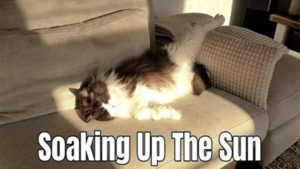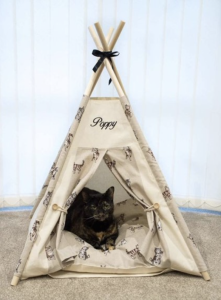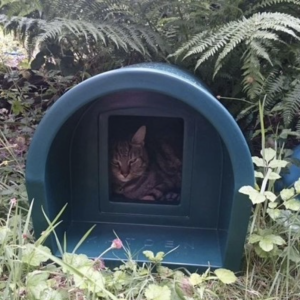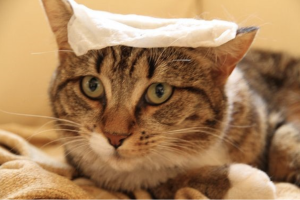Dangers in Very Hot Weather
By E G D McCarrison BVMS MRCVS

We know that cats originated in the Near East and Egypt so it is tempting to think that they will be accustomed to, and therefore have adapted to, hot weather. They do indeed like lying in sunny spots and are very good at conserving moisture – the latter is why a lot of cats do not seem to drink very much. However, today’s domesticated cats (especially in the UK) are not used to the increasingly frequent hot weather conditions that are now occurring most years.

As responsible cat owners we all want to ensure the health and wellbeing of our cats. The weather does appear to be changing, so we need to be prepared to take steps to protect them from periods of excessive heatwave temperatures. Heatstroke can kill our feline companions!
Water and Ventilation
Assuming that your cat is going outdoors we must make sure that they always have access to fresh water and areas of shade. Obviously we can only do that in our own gardens or yards, but your cat is probably not going to stray too far in very warm weather anyway. Putting ice cubes in the water regularly will help to keep it cool for longer. Giving your cat wet food instead of dry is a good way of getting fluids into those cats who do not drink much. Perhaps mix a tablespoon of cold water into the food too.
On very hot days it may be best to keep them indoors in the cool, and I certainly recommend this for white cats. Where it is safe, keep doors and windows open….this will enable any cool breezes to circulate through the house. In the absence of cool breezes, use a fan (or air conditioning if you have it) to cool off rooms. You may well be doing this for your own benefit anyway.
Spread dishes of cold water with ice cubes in strategic spots around the cooled rooms. It is said that wide glass/ceramic/or metal bowls keep the iced water cooler for longer. Keep the water away from their food and toilet areas. All of this applies to water placed in shaded areas of your garden too.
Cat Beds

Most cat beds are designed with materials to keep your cat warm and cosy. In hot weather these are likely to be abandoned (for obvious reasons), so you might consider getting a more ‘lightweight’ bed, or even a ‘cooling-mat’. Your cat will be grateful to you for providing this.
Sunburn
Sunburn can lead to cancer, so it is extremely important that your cat does not spend too much time lying in sunny spots.
In the event that your cat/s prefer to be outside, and becomes agitated if kept indoors, then it is essential to apply ‘cat-friendly’ sun cream to the most sensitive area (such as noses, the tips of the ears, and any areas where the fur is thin). White cats frequently have pink ears, which burn easily, and these must be protected with the cream being spread all over the ears. If in doubt about the best cream to use, ask your vet for a recommendation. Certain sun creams for humans can prove toxic, and therefore dangerous, to cats (such as those with zinc oxide and salicylates)……..so beware!
Red and sore-looking skin is a typical sign of sunburn, so it is useful to remember that the sun is usually at its strongest between 10am and 3pm.
Dehydration
I have already covered earlier the need for your cat/s to drink enough water. If they don’t, they easily get dehydrated in hot weather. Signs of this can include:
- Cool or cold paws
- Sticky gums
- Dry and sunken eyes
- When you pinch and gently lift the skin, it doesn’t then immediately fall back into its previous position when you let go
Hyperthermia and Heatstroke
Heatstroke can kill your cat, so you MUST treat any signs of this as an emergency!
Whilst there are a number of signs, only a few may be apparent in your cat. In any event, an immediate call to your vet is needed if any of these are seen:
- Panting and/or difficulty in breathing
- Dizziness – mostly demonstrated by staggering or wobbly legs
- Drooling
- Vomiting
- Lethargy
- Very red or pale gums
- Diarrhoea
- Seizures
- Apparent weakness
- Restlessness
- Tremors
- Collapse
Obese (overweight) cats, cats with extremely thick fur, and certain breeds are at increased risk of hyperthermia and heatstroke, so please be extra vigilant.
Outside
Don’t forget that fleas and ticks are in abundance in hot weather, so do keep up with the control of these. See fleas.
Sheds/ garages/conservatories and greenhouses tend to get left open more in hot weather, and the danger of your cat being shut into such warm enclosures cannot be over-emphasised. They will become intolerably hot, and suffer considerably. If you are going out, and closing various doors, be absolutely sure that your cat is not asleep in any of these places.
NEVER leave a cat in a car, even for a short period.
The hard surfaces outside, such as paving-stones and artificial grass, become very hot in extreme heat and can easily cause blistering to your cat’s paws. Cats sweat thru’ their paw pads in order to cool down, hence damage to the pads can cause additional difficulties in hot weather. It is a therefore a good idea to check the pads of your outdoor cat on a reasonably regular basis during very hot weather.

Ensure that there are plenty of shady places in your garden for your cat to get away from the heat of the sun. If the layout of your garden plants is such that this is impossible then an open box, on its side and pushed in-between and underneath tall shrubs (facing away from the sun but accessible to your cat) can, with a little imagination, be made into a good refuge from the heat.
Finally, if you have ANY reason to be concerned that your cat is not coping well with the heat during hot summers then please move your cat to a cooler place, put a cold damp cloth over his/her head and neck area, try to persuade it to drink a little cool water (perhaps using a dropper in the side of his/her mouth) and telephone your vet.
Thank you for reading this page, and for caring for your cat/s.

General
"Cats are connoisseurs of comfort"
James Herriot

 menu
menu